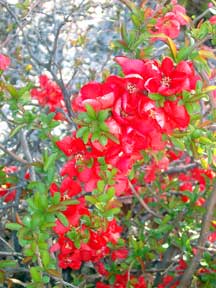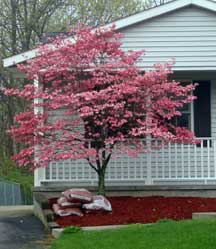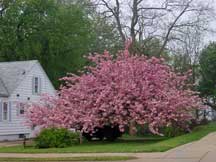Spring 2006: a season of memorable blooms
Editor’s note: This article is from the archives of the MSU Crop Advisory Team Alerts. Check the label of any pesticide referenced to ensure your use is included.
Every few years, a growing season comes along that is truly memorable. Sometimes a cold, wet summer such as the one we had two years ago is the memory. Last year’s summer seemed so hot gardeners were just sighing with relief when fall finally came. This year the memory may be the spring that delighted our senses with amazingly abundant blooms.

Brilliant displays of bloom on
flowering quince are just the tip
of the iceberg this year.
Forsythia, flowering quince, redbud and dogwood have all been blooming with extraordinary intensity this season due to several unique growing conditions, according to Michigan State University Professor of Horticulture Robert Schutzki. The eye-popping forsythia and other flowering trees and shrubs are actually working on producing their flower buds the summer before bloom, he explains. When plants are under some type of stress, they tend to expend more of their carbohydrate reserves on producing flower and fruit buds. (Sometimes this phenomenon is used as an indicator of stress or poor health when diagnosing plant problems in the landscape.)

Pink dogwood.
Last summer, you will remember was scorching hot and relatively dry during the bud-set period. Most flowering plants responded with excellent production of flower buds.
The second environmental factor leading to such a great show, he said, was the relatively moderate winter. Especially for shrubs like forsythia, the plant is hardy but the flower buds tend to be killed out during a deeply cold winter. For the most part, we are experiencing no bud kill this year which rewards eager gardeners with lots of flowers.

Kwanzan cherry.
A third factor entering the mix is the relatively dry spring we have experienced, coupled with warm days and warm nights. This environmental condition pushes bloom activity along rapidly in the drowsily dormant plants. Normally spring approaches slowly with warm days and cool nights so bloom time is extended over a longer period of time. Plants this year are reaching full bloom earlier and overlapping bloom with other plants that would normally be a bit delayed. Rainfall amounts have been light and gentle in nature so very few of the blooms have been whipped off by high winds or heavy rain or ice.
It isn’t every year that we get to see such a show. I suggest you get out there with your camera. This is the spring that every novice photographer can shoot “magazine cover” photos!
Why some plants fail to bloom
Gardeners frequently ask me why plants fail to bloom. The most common question is about Wisteria. For the most part, plants need to be in a mature phase in order to set flower buds. Some plants, such as wisteria, take a fair number of years before they are ready to start blooming. As I mentioned above, stress can induce plants to bloom. Apple growers have used this phenomenon to trick the slow-to-fruit Northern Spy apple into producing buds. The technique used was simply root pruning the plant in a manner that would reduce its intake of nutrient and water. Root pruning can help plants like wisteria get “kicked into action” but one must use some caution as well. Sometimes it is best to wait it out.
A second reason that a plant may fail to bloom is that the growing conditions are just the opposite of stressful. In an abundantly moist, nutrient-rich soil, the plant is so happy growing, it never takes the time to reproduce. I discovered this the hard way with my Rhododendrons. I had been generously applying fertilizer each season only to find that the plants responded with loads of growth and no flowers. Since that time, I don’t apply any fertilizer and the plants have gotten into a very normal pattern of moderate growth and annual bloom.
Lastly, some plants tend to be “biennial bearing.” What this means is that plants such as flowering crab or even dogwood can bear heavily one season and hardly at all the next. This is generally hard to combat. Moderating fertility can help, but hopefully with time the plants will come to some sort of balance and produce more evenly.
Related Source:



 Print
Print Email
Email


